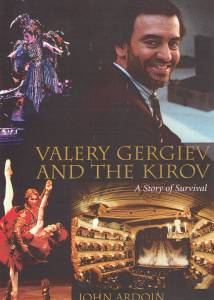GERGIEV AND THE KIROV
As John Ardoin observes
in the opening pages of VALERY GERGIEV AND THE KIROV--A STORY OF SURVIVAL
(Amadeus Press), his book is "four books in one: a portrait of the
company's present-day head...a history of the building and those who have
occupied it since the theater opened in 1860; a personal journal I kept
in which the Marinsky's composers, repertory and personalities were seen
through the sensibilities and interests of someone from the West; and,
perhaps most important, the story of a major Russian theatrical entity
attempting to survive in the turmoil and corruption of the post-communist
period."

Located in St. Petersburg (known also as Petrograd and Leningrad), the
Kirov has always taken a back seat to Moscow's Bolshoi Theater, due largely
to political factors. St. Petersburg was "always a thorn in the side
of the communists," writes Ardoin, "even though it gave birth
to their movement and they consistently paid lip service to its role in
the history of their party, it was distrusted by Lenin, and even more
by Stalin. St Petersburg was too intellectual, too independent in spirit,
too European."
As a consequence, the Bolshoi was better subsidized and promoted during the Soviet period, and the Kirov was relegated to second-class, regional status. With the fall of communism, though, the Kirov was able to fight its way back to not just national but international prominence, thanks to Gergiev's inspired and tenacious leadership. The latter was only 35 when he took control in 1988; within five years he had turned the Marinsky Theatre (the Kirov's original name) into a world-class opera and dance company.
Gergiev chose to devote his life to this all-consuming struggle. One of the most highly regarded conductors of our time, he could have made an easier and more lucrative living working in the West, but as Ardoin explains, "he is possessed by a sense of mission, and that mission, is in large measure, to protect and preserve the traditions and the repertory born and nurtured at the Marinsky."
Ardoin's love for the Marinsky just about matches Gergiev's. The author has done a copious amount of research on the theater's history, but he is never pedantic or boring when writing about it, and his portraits of some of the fabled artists associated with the theater--Vinogradov, Baryshnikov, Borodina, Petipa and Diaghilev, to name but a few--are graceful and insightful.